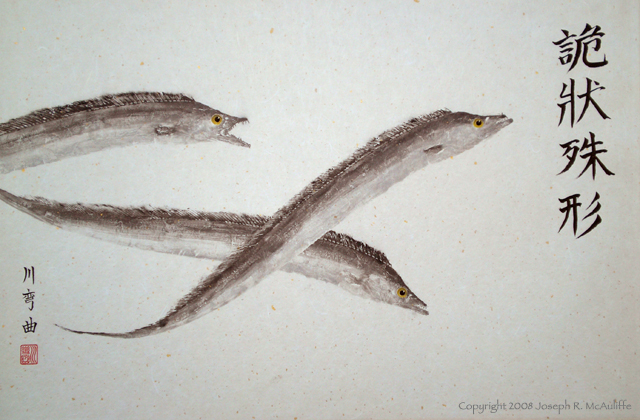
With open mouth and fang-like teeth, the Pacific cutlassfish is a fearsome-looking predator. It is one of about 40 species in the cutlassfish family (Trichiuridae), found in seas around the world. Members of this family are typically long, slender, and steely blue or silvery in color, hence the name “cutlassfish.” They are also known by several other descriptive common names, including beltfish, ribbonfish, and scabbardfish. The Pacific cutlassfish (Trichiurus lepturus) shown here is found worldwide in temperate and tropical coastal waters (populations of the same species from the Atlantic Ocean are called Atlantic cutlassfish).
This species of cutlassfish does not possess the full set of fins that most fish have. It lacks paired pelvic fins and an anal fin. It also lacks a caudal (tail) fin, earning it yet another common name: the “largehead hairtail.” In a typical fish, the broad tail’s sweep provides the power stroke that propels the fish rapidly forward. Without such a tail, the cutlassfish undulates its whole body like an eel in order to swim. This style of swimming is not very fast and most of their prey can probably swim much faster. Consequently, instead engaging prey in hot pursuit, the cutlassfish lies in wait and ambushes its prey in a novel way. At dusk, young cutlassfish and smaller adults migrate from deeper waters to a short distance below the water surface. There they suspend their long bodies nearly vertically, with the toothy jaws facing upward and long tapered body hanging downward. Nearly motionless in this position, they present a very small visual cross-section to small fish or squid swimming just above them. If an unsuspecting prey ventures near, the cutlassfish lunges upward and seizes it with wide-open mouth and fang-like teeth. If the cutlassfish is very near the surface, the forceful lunge can propel it straight upward, out of the water.
Fearsome as this toothy predator is in both appearance and hunting tactics, it is certainly not the sea’s top predator. Several kinds of dolphins inhabiting the Atlantic and Pacific Oceans prey heavily on this species of cutlassfish. Seals and sea lions in both North and South America also consume them. In some places, the cutlassfish is the most common prey in the diets of some of these marine mammals. Cutlassfish are also eaten by larger fish, including blacktip sharks in the Gulf of Mexico. Perhaps the cutlassfish’s relatively slow swimming makes it particularly vulnerable to such an array of fast-swimming, larger predators. Avoiding those predators involves another game of stealth. During daylight hours, juvenile and small adult cutlassfish form schools in deep water, concealed by the depth’s darkness. Under the cover of night, they ascend to feed near the surface.
Large predators are not the only ones that are sustained by the cutlassfish. Like most animals with backbones, the cutlassfish is home to legions of internal parasites that include flukes, tapeworms, spiny-headed worms, roundworms and copepods. These parasites live within the abdominal cavity, gut, muscles, or on the gills, and collectively consume a small lump of flesh from each fish without killing their hosts.
Without a doubt though, the largest “lump” of cutlassfish flesh is now consumed by human beings. It is a highly prized food fish in Asia. The Pacific cutlassfish is the most important marine fish species harvested in the coastal waters of China and catches of this fish account for 10-20% of the total weight of China’s marine fish catch. China accounts for about 80% of the world’s harvest. Within the last two decades, fishing pressure has increased markedly in China. In 1990 China, South Korea, Russia, and Japan reported a total catch of just over 750,000 metric tons. The world-wide, total catch reported in 1999 was 1,418,944 metric tons. Most cutlassfish harvested are a kilogram or less in weight; if the average weight per individuals was a kilogram, the total worldwide harvest in 1999 would have been slightly over 1.4 billion individual fish. Populations of Pacific cutlassfish in areas from the central to the northern coasts of China have been overexploited and populations have declined due to such heavy fishing pressure.
The calligraphic inscription is a Chinese four-character idiomatic expression “gui zhuang shu xing,” which means “fantastic shapes and strange forms.” I thought this expression was especially fitting because the three knife-like strokes comprising the right half of the last character “xing” reminded me of the shapes of the three pictured fish.
Size: 36 x 24 inches (2007)
Return to Gallery 4.